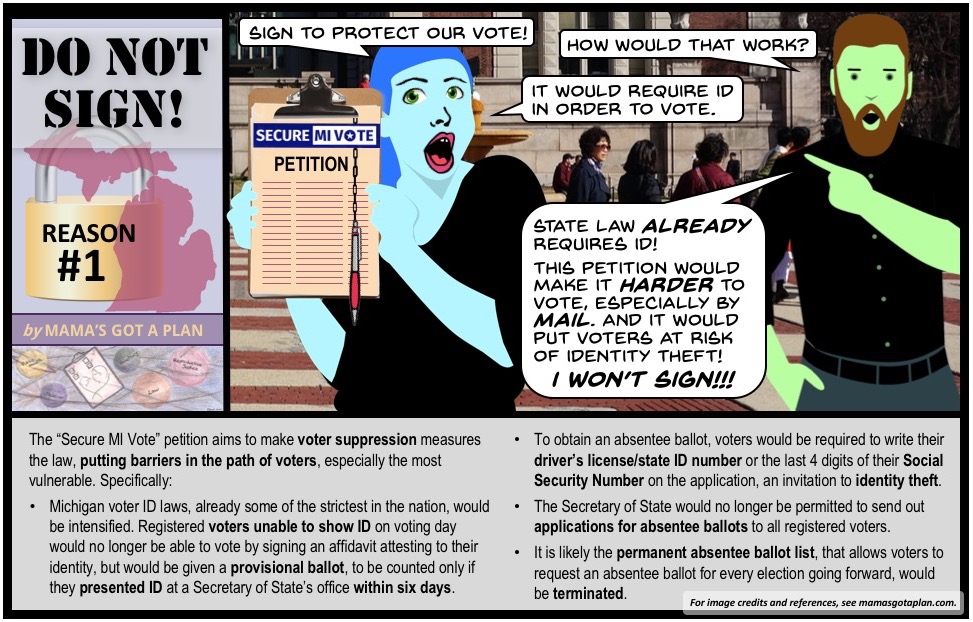What this cartoon is not about
- Abortion, and whether it’s good or bad to have one.
- Vaccines, and whether it’s good or bad to have one.
People will and do differ on these questions. This cartoon assumes that you want to do the good thing, whatever that is, and that a bad thing is mistreatment or exploitation of people of Color based on racism, whether intentional or not. Are we clear?
What this cartoon is about
 Click image to open larger version in new window.
Click image to open larger version in new window.
<a href="https://mamasgotaplan.files.wordpress.com/2021/06/210609-one-moral-concern.jpg" alt="C" width="1018" ><img="" class="wp-image-2081 size-full aligncenter" style="margin-bottom: 0;" title="CLICK TO ENLARGE!"
<a href="https://mamasgotaplan.files.wordpress.com/2021/06/210609-one-moral-concern.jpg" alt="C" width="1018" ><img="" class="wp-image-2081 size-full aligncenter" style="margin-bottom: 0;" title="CLICK TO ENLARGE!"  Some people with concerns about the safety or efficacy of vaccines object to the presence of “aborted fetal cells” in vaccines. However easy (and gruesome!) it is to picture a dismembered hand pushing up through a syringe’s liquid, that is not the reality. As the blue-jacketed person in Frame 3 tries to point out, what is in question are cell lines. How are cell lines formed? Scientists use cells taken from
Some people with concerns about the safety or efficacy of vaccines object to the presence of “aborted fetal cells” in vaccines. However easy (and gruesome!) it is to picture a dismembered hand pushing up through a syringe’s liquid, that is not the reality. As the blue-jacketed person in Frame 3 tries to point out, what is in question are cell lines. How are cell lines formed? Scientists use cells taken from  an organism, e.g. kidney cells taken from a dead human embryo, and create a replicating cell line. The original kidney cells eventually die off, just as cells in the body do, and are replaced by genetically identical cells created by standard biological cell division. These cells are then combined with viruses and used to create a vaccine. (For fascinating photos of human embryonic stem cells, see here.)
an organism, e.g. kidney cells taken from a dead human embryo, and create a replicating cell line. The original kidney cells eventually die off, just as cells in the body do, and are replaced by genetically identical cells created by standard biological cell division. These cells are then combined with viruses and used to create a vaccine. (For fascinating photos of human embryonic stem cells, see here.)
Given this significant distance in both time and nature between embryo and vaccine, what are the moral and practical grounds for boycotting the vaccine because of this association? Those who wish to discourage abortion will not do so by refusing vaccines; the abortions that created the cell lines involved took place decades ago. Should a scientist decide to create a new cell line from embryonic material, current U.S. ethical rules1 forbid the solicitation of pregnant people to terminate pregnancies for the purpose of supplying material for scientific research. People will no doubt continue to terminate pregnancies and the products of conception might subsequently be donated to science, but disrupting that relationship will not prevent abortions.
Do boycotts ever work?

1979 divestment protest, University of Michigan
Boycotts have been effective in other circumstances. Starting in the 1970s, a divestment movement demanded that global institutions isolate South Africa from external trade and investment as a way of pressuring the regime to break down its racial Apartheid system. It worked! South African carried out reforms, a civil war was averted, a Truth and Reconciliation commission took place, and eventually Nelson Mandela became president. By the mid-1990s, Apartheid was no more. In South Africa’s case, the objectionable behavior – the subjugation of a majority of the citizenry – was ongoing. The intense financial pressure applied in the boycott served as an incentive for the government to change its behavior.
Harm that can be redressed – but how?
 Other wrongs, however, remain to be righted: consider the case of Henrietta Lacks. The HeLa cell line was developed from cells taken from the cervical tumor that killed Lacks in 1951. The line has been successfully used for far-reaching discoveries in cancer drugs, space research, and immunology, including in the study of COVID-19 in search for a vaccine. The moral issue arises from the fact that while great good came of the establishment of the line, none of that good was directed specifically toward the Lacks family.
Other wrongs, however, remain to be righted: consider the case of Henrietta Lacks. The HeLa cell line was developed from cells taken from the cervical tumor that killed Lacks in 1951. The line has been successfully used for far-reaching discoveries in cancer drugs, space research, and immunology, including in the study of COVID-19 in search for a vaccine. The moral issue arises from the fact that while great good came of the establishment of the line, none of that good was directed specifically toward the Lacks family.
The cell line was created from cells taken from Henrietta Lacks, all without the knowledge or permission of the the Lacks family. This practice was and is perfectly legal, as validated by a 1990 California case: the court found that patients do not own any blood or tissue samples taken from their bodies, nor do they possess a right to share in profits from research activities that made use of those samples. However, in HeLa’s case it is difficult for us to ignore the vast gulf between the sums generated by the cell line and the reality of the lives of the Lacks family, who were African-American tobacco farmers in Virginia at a time of blatant racial discrimination. Because such inequalities continue and magnify down through the generations, this injury can be considered an ongoing one.
Should we refuse COVID vaccines because of what was done to the family of Henrietta Lacks? The last panel of the cartoon shows the absurdity of such a proposal: even if it were possible to discard the findings of the space program (!), how would such an action help the Lacks family?
Restorative justice

Let’s try that again.
The concept and practice of Restorative Justice provides a way to compensate victims of injustice, while simultaneously working to prevent future similar injustices. Once used primarily as an alternative within the criminal justice system to address individual instances of property crime, Restorative Justice is now beginning to be deployed more broadly to tackle systemic injustice and inequity.2 The Restorative Justice framework would dictate compensation for the Lacks family and a strategy to reform medical research so that research subjects, particularly those whose bodies were historically used for others’ profit, would be assured of enjoying the benefits of the research.
Following the publication of Rebecca Skloot’s 2010 book on Henrietta Lacks, her descendants established a foundation to “preserve her legacy by educating future generations on the impact of her phenomenal HeLa cells while promoting health equity and social justice.”  In fact, August 1, 2020 marked the beginning of a year’s “Cellebration” of the 100th anniversary of Henriette Lacks’s birth. Today, February 14, 2021, the day of this blog post, the foundation suggests a donation of $14 as a “V-Day gift.” It is also worth noting that the foundation actually advocates for receiving the COVID-19 vaccine as a way to honor the legacy of Henrietta Lacks.
In fact, August 1, 2020 marked the beginning of a year’s “Cellebration” of the 100th anniversary of Henriette Lacks’s birth. Today, February 14, 2021, the day of this blog post, the foundation suggests a donation of $14 as a “V-Day gift.” It is also worth noting that the foundation actually advocates for receiving the COVID-19 vaccine as a way to honor the legacy of Henrietta Lacks.
Similarly, those who wish to decrease the number of abortions might also consider a Restorative Justice approach. All birthing people, but especially people of Color, who are disproportionately represented among people terminating pregnancies, should be guaranteed sufficient health care access and financial support so that those who wish to do so can carry their prenates to term and parent all their children in safety and with dignity. Data from the Guttmacher Institute, as reported by CBS News, suggest that the inability to afford a baby is a reason for 73% of women who obtain abortions. Obviously, the fate of prenates who were not carried to term cannot be changed. But the fate of birthing people can. It would make sense for everyone, whatever their position on abortion, to support organizations that fight to improve circumstances for birthing people and their children, like Mothering Justice, Black Mamas Matter Alliance, and others.
One moral concern?
 Finally, regardless of the utility of boycotts and the application of a restorative justice lens to problems of fairness and equality, is there ever a world in which one moral concern can override all others? You might believe, for example, that your cause in life is to save elephant species from extinction. They are beautiful, intelligent animals, and you are sure they have souls. You might feel moved to decline a vaccine because it was created using, say, cells from elephant ivory,3 which poachers obtain by killing the animals. But to ignore all other issues – climate change, political unrest, or a world pandemic, perhaps? – not only means that an opportunity to save the elephants might elude you, but also suggests a lack of connectedness to the larger world. Friends, the world needs many things. We our connected to our natural world and to one another. Please, let us consider multiple viewpoints and multiple approaches for our mutual aid.
Finally, regardless of the utility of boycotts and the application of a restorative justice lens to problems of fairness and equality, is there ever a world in which one moral concern can override all others? You might believe, for example, that your cause in life is to save elephant species from extinction. They are beautiful, intelligent animals, and you are sure they have souls. You might feel moved to decline a vaccine because it was created using, say, cells from elephant ivory,3 which poachers obtain by killing the animals. But to ignore all other issues – climate change, political unrest, or a world pandemic, perhaps? – not only means that an opportunity to save the elephants might elude you, but also suggests a lack of connectedness to the larger world. Friends, the world needs many things. We our connected to our natural world and to one another. Please, let us consider multiple viewpoints and multiple approaches for our mutual aid.
Updated June 9, 2021: graphic replaced and small stylistic changes made
1The Common Rule (45 CFR part 46), the Federal Policy for the Protection of Human Subjects, was established in 1991. It is enforced by research institutions through Institutional Research Boards. Note that the Common Rule applies only to medical research, not medical practice.
2“Restorative justice began as an effort to deal with burglary and other property crimes that are usually viewed (often incorrectly) as relatively minor offenses. Today, however, restorative approaches are available in some communities for the most severe forms of criminal violence: death from drunken driving, assault, rape, even murder. Building upon the experience of the Truth and Reconciliation Commission in South Africa, efforts are also being made to apply a restorative justice framework to situations of mass violence. These approaches and practices are also spreading beyond the criminal justice system to schools, to the workplace and religious institutions. Some advocate the use of restorative approaches such as circles as a way to work through, resolve and transform conflicts in general.” Zehr, Howard. The Little Book of Restorative Justice: Revised and Updated. New York: Skyhorse Publishing Company, Incorporated, 2015. See also “Restorative Justice as a Social Movement,” in Mark Umbreit and Marilyn Peterson Armour, Restorative Justice Dialogue: An Essential Guide for Research and Practice, 2010.
3Completely fabricated, in order to make a point.
Further reading
Image credits
All images are shared under a Creative Commons license, unless otherwise noted. Where required by license, changes to the image are noted.











 Some people with concerns about the safety or efficacy of vaccines object to the presence of “aborted fetal cells” in vaccines. However easy (and gruesome!) it is to picture a dismembered hand pushing up through a syringe’s liquid, that is not the reality. As the blue-jacketed person in Frame 3 tries to point out, what is in question are cell lines. How are cell lines formed? Scientists use cells taken from
Some people with concerns about the safety or efficacy of vaccines object to the presence of “aborted fetal cells” in vaccines. However easy (and gruesome!) it is to picture a dismembered hand pushing up through a syringe’s liquid, that is not the reality. As the blue-jacketed person in Frame 3 tries to point out, what is in question are cell lines. How are cell lines formed? Scientists use cells taken from  an organism, e.g. kidney cells taken from a dead human embryo, and create a replicating cell line. The original kidney cells eventually die off, just as cells in the body do, and are replaced by genetically identical cells created by standard biological cell division. These cells are then combined with viruses and used to create a vaccine. (For fascinating photos of human embryonic stem cells, see
an organism, e.g. kidney cells taken from a dead human embryo, and create a replicating cell line. The original kidney cells eventually die off, just as cells in the body do, and are replaced by genetically identical cells created by standard biological cell division. These cells are then combined with viruses and used to create a vaccine. (For fascinating photos of human embryonic stem cells, see 
 Other wrongs, however, remain to be righted: consider the case of Henrietta Lacks. The HeLa cell line was developed from cells taken from the cervical tumor that killed Lacks in 1951. The line has been successfully used for far-reaching discoveries in cancer drugs, space research, and immunology, including in the study of COVID-19 in search for a vaccine. The moral issue arises from the fact that while great good came of the establishment of the line, none of that good was directed specifically toward the Lacks family.
Other wrongs, however, remain to be righted: consider the case of Henrietta Lacks. The HeLa cell line was developed from cells taken from the cervical tumor that killed Lacks in 1951. The line has been successfully used for far-reaching discoveries in cancer drugs, space research, and immunology, including in the study of COVID-19 in search for a vaccine. The moral issue arises from the fact that while great good came of the establishment of the line, none of that good was directed specifically toward the Lacks family.

 Finally, regardless of the utility of boycotts and the application of a restorative justice lens to problems of fairness and equality, is there ever a world in which one moral concern can override all others? You might believe, for example, that your cause in life is to
Finally, regardless of the utility of boycotts and the application of a restorative justice lens to problems of fairness and equality, is there ever a world in which one moral concern can override all others? You might believe, for example, that your cause in life is to 



 For whatever reason, people seem to fixate on the shoelace. Even Embezzler Home Birth Dad, who surely should know better, feels the need for one. With such depictions so ubiquitous, it’s hardly surprising that parents, first responders, and even medical providers believe that immediate clamping and cutting of the cord is an urgent necessity.
Fortunately, care of the cord following a precipitous birth is remarkably simple: Do nothing.
Want to know more? The 2016 article
For whatever reason, people seem to fixate on the shoelace. Even Embezzler Home Birth Dad, who surely should know better, feels the need for one. With such depictions so ubiquitous, it’s hardly surprising that parents, first responders, and even medical providers believe that immediate clamping and cutting of the cord is an urgent necessity.
Fortunately, care of the cord following a precipitous birth is remarkably simple: Do nothing.
Want to know more? The 2016 article